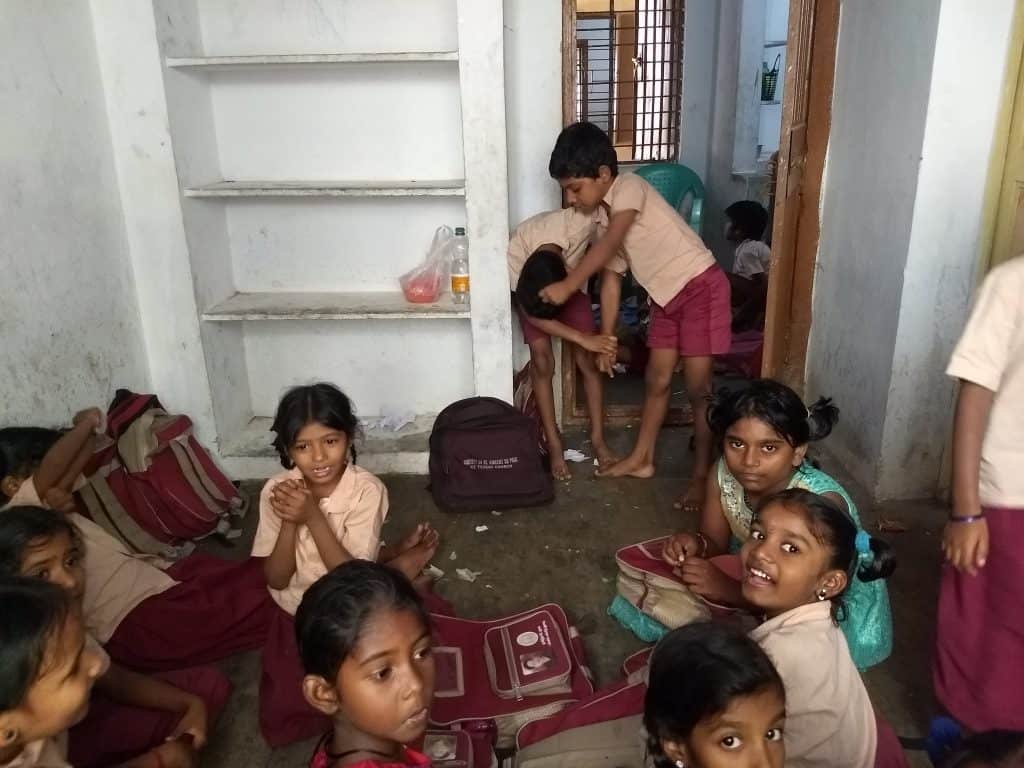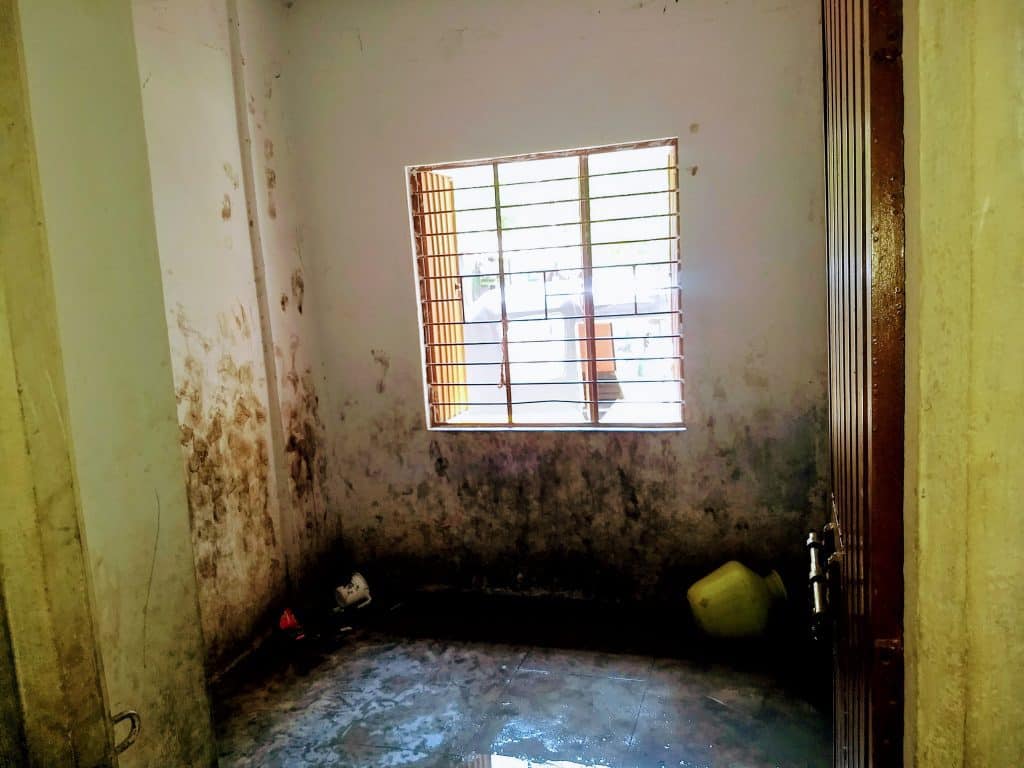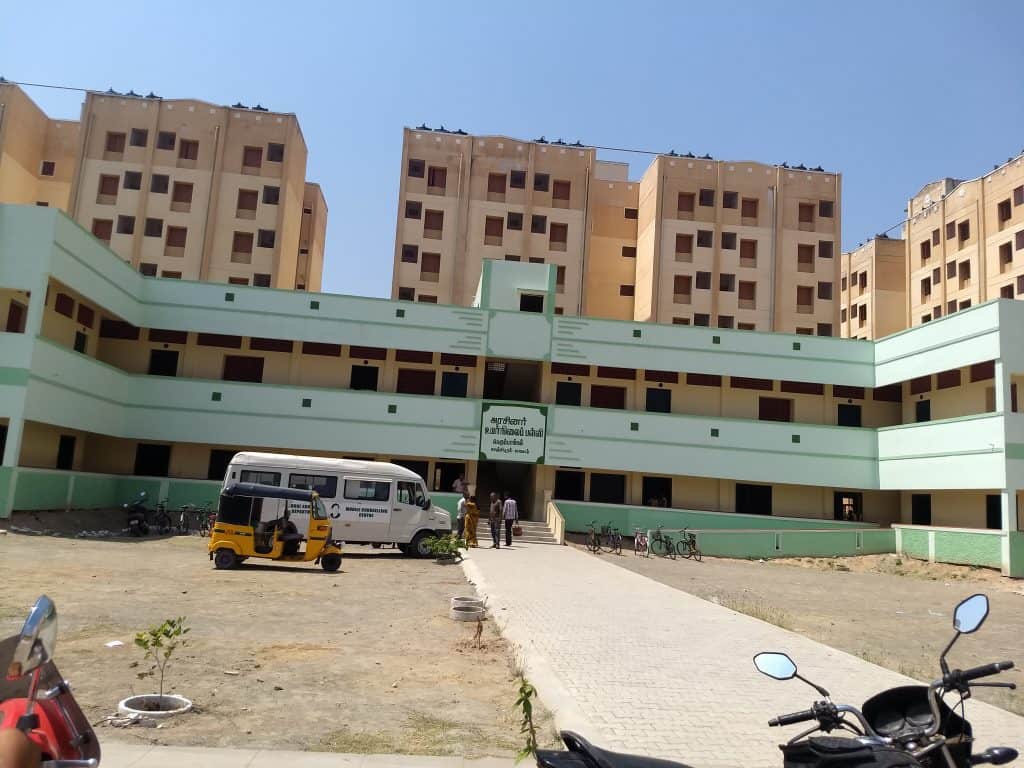On a humid Thursday afternoon, a group of students, with torn maroon uniforms and bruises on their malnourished bodies, make their way out from the primary school in Perumbakkam resettlement colony. Bunking the first class after the lunch break, students are busy making plans for the day. While one student suggests fishing in a swamp opposite the settlement, another wants to play cricket. The teacher-in-charge at the primary school turns a blind eye to the mass bunking, perhaps because it would take the load off her shoulders.
It is only the noise made by the kids that could give you a hint that the ground floor (of Block A) in this eight-storied residential building at Ezhil Nagar resettlement is a functional school. There is no name board. No playground. On either side of the dark corridor are the flats converted into classrooms. Students study there, packed like sardines to use an oft-used idiom.
The makeshift primary school is an initiative of the Tamil Nadu Slum Clearance Board (TNSCB), which relocated the slum dwellers from the banks of Adyar and Cooum to the colony here, after the flash floods of December 2015. About 346 children from the colony have been studying here for more than two years, in cramped conditions hardly conducive to quality education.
Violating the Right to Education
With no playground, no fire safety clearance and a lack of adequate teaching staff, the school brazenly violates various mandates of the Right of Children to Free and Compulsory Education Act, 2009 (RTE Act). There is a common restroom for children of both genders and most of the classrooms have no teachers in them, leading to frequent fights among the children. Bullying and brawls are common.

Students frequently get into tiffs in the classrooms that have no attending teacher. Pic: Laasya Shekhar
K Sumathi*, a parent said, “At least once a month, my son comes home with punches on his face. The teachers have grown indifferent to my complaints.”
Parents, however, have no choice but to send their children to this school, as there is no other primary school in the vicinity of Ezhil Nagar. A high school was also run from the residential space here till three months ago, after which it was shifted to a separate premises, opposite the settlement.
The high school headmaster evaded questions as he simply concluded, “It is not a serious problem. A separate primary school will be constructed within the next academic year.”
An official from the TNSCB, who is in-charge of the Perumbakkam resettlement said that land has been allotted to construct a primary school for the children.
Unkept promises
Despite such assurances, one cannot ignore the fact that a primary school is functioning without following any norms. Moreover, researchers point out that the amenities in the Perumbakkam resettlement are much less that what had been promised.
In response to an RTI petition filed by the Information and Resource Centre for the deprived Urban Communities (IRCDUC), the TNSCB stated that it would construct 5 primary schools, 2 high schools and 2 higher secondary schools. “After complete resettlement, the locality will have at least 19,000 students, which requires construction of 11 schools. But there is a provision for only nine schools in the layout,” said Vanessa Peter, policy researcher, Information and Resource Centre for the Deprived Urban Communities.
While activists feel that the proposed numbers are inadequate in themselves, the TNSCB could not even meet its own promised targets.The current reality is that there is only one high school and one primary school, the latter operating in an inappropriate place.
“The primary school is functioning alongside the tenements where people reside. Safety of the children is a big issue, since there is no emergency exit in the 8-storied building. Providing inadequate facilities to the children of socially disadvantaged sections is a violation of the RTE act,” said Vanessa Peter.
The only ray of hope in the situation is that the high school, with ample space for sports and games and hygienic restrooms, has about 330 students.
Students in the doldrums
The absence of a higher secondary school in the vicinity creates another problem. Students have to travel for more than two kilometres in crowded buses, to study in a higher secondary school in Shollinganallur. A student, Giri Kumar said, “Even though there is a school in Semmencherry, most of us go to Shollinganallur, since there are not enough teachers in the former one. We go to the school by bus and sometimes walk, when there is no bus.”
The paucity of facilities has led to an increase in the drop out ratio among students who have completed high school. “Due to the difficulties in commute, many children, especially girls, quit school after the tenth. They take up petty jobs,” said K. Tamilselvi, a resident, who has been sending her daughter to a higher secondary school, in the face of several odds.
The glaring gaps in the various aspects of the lives of residents here can be directly attributed to poor governance. “The issue of the urban poor is not just housing, but various issues surrounding it. Despite being the highest recipients of funds for housing projects in the country, the Tamil Nadu government has not formulated a holistic policy for the relocation and rehabilitation of the urban poor,” says Vanessa.
From eviction to relocation, the Tamil Nadu Slum Development Board has not been adhering to the rules, allege activists. “While eviction is often done without informing the slum dwellers, there is no proper rehabilitation. All the government does is hide the urban poor from the more visible precincts of the city,” says Anupriya Murugesan, a social worker.


19000 students!! . It’s a huge number.. Needs attention from public and authorities..
The existing ground floor school in Perumbakkam was converted to a high school by constructing a first floor with 6 classrooms and toilets for boys and girls. This was done by Bhoomika Trust. The school now accomodates 300 children who were earlier being schooled in the tenement blocks.
Bhoomika Trust will now be building a primary school for the children in the tenements reported in this story , the plans are being readied.